17 September 2010 (Aggie Theatre, Ft Collins CO)The Aggie does a good job with hop shows, usually creating an extravaganza. Friday night's show continued the tradition, putting a full line up of four rap groups, with DJ music before and between. Local DJ, Jimmy Hands warmed up the crowd and kept them hot between acts with occasional help from DJ True Justice (
Bayliens) and a couple of other rappers. The mix of styles was balanced: plenty of variety but the crowd was into each of the acts.
Jimmy Hands

DJ
Jimmy Hands started the show early, creating a series of
mashups to get the crowd moving. These weren't "blow your mind" mixes, just some solid tracks to get people dancing and ready for the main acts. During the
warmup, DJ True Justice from the
Bayliens came out to help hype the audience. He kicked up the energy level, coaxing everyone to follow his guidance - cheers, call and response, hand waving - all of this created the "show" mindset.
This is one of the strengths of a hip hop show. By having a DJ work in between the other acts, the energy level never gets a chance to leak away. So the climax of one band's set drives the start of the next one.
Jimmy Hands didn't limit himself to straight hip hop
mashups. He built some smooth tracks using some
electronica and trip hop grooves. He also showed off his scratching skills.
The Food Chain
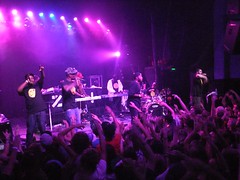 The Food Chain
The Food Chain dominated the stage when they came out. Four
MCs fronted a band including a live drummer and three keyboard players. The keyboard guys covered a lot of ground, laying down some beats, regular keyboard lines, and samples. This is a Denver super group, pulling in players from across the scene. Fitting for a collective, everyone got plenty of stage time and attention
The
MCs rapped ensemble style, trading off lines and chiming in at the ends of each others' phrases. The feel was loose and organic: it could have been tighter, but the visual appeal counted for a lot. It also would have helped to have a better mix, bringing the vocals out more. Despite those quibbles, the main thing was the fun they were having on stage and sharing with us.
Lyrically, the songs shotgunned a range of styles from conscious rap to party time. Musically, they favored R&B style backing grooves, but they weren't locked into that. Some of their most effective songs combined sparse keyboard lines with a heavy drum beat. From song to song, the Food Chain delivered a mainstream rap feel.
There were two high points in their set. One was a drumming contest between one of the keyboards and the drums, with some smooth call and response. Shortly after this, Mo Heat laid down some rocking guitar lines on the keyboards. Deftly working the pitch wheel and riffing, he created a Steve
Vai/Zappa-
esque guitar sound: harmonized and slightly angular, it filled out The Food Chain's musical sound and contributed to a rich jam.
The Bayliens
 The Bayliens
The Bayliens had a three prong attack: MC and DJ True Justice, Spaceman Cell, and Enzyme Dynamite. The three guys created a party vibe during their set. This culminated in pulling a pack of girls onto the stage for the end of their set.

The
Bayliens favored a more modern sound, mixing in some heavy electronic backing tracks and jamming off a mash up with
Sweet Dreams (The
Eurythmics). They all had good flow, laying down some
Beastie Boys lyrical hand-offs and building up some serious rapid-fire delivery.
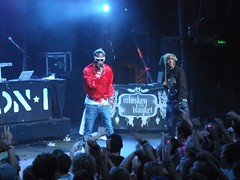
The band comes out of East Bay and they've achieved some attention already, with a radio hit,
Bubble Gum. They tend to play for laughs rather than being too serious, which the was fine with the crowd. All of the
Bayliens were strong working the stage. They stalked the stage front, inciting the audience to fuller participation. Tossing out
CDs is an easy way to buy a crowd, but the
Bayliens seemed even more interested in getting their music into more people's hands (and ears).
Whiskey Blanket

It's telling that a local band, Boulder's
Whiskey Blanket, had the number two spot for the show.
In the 18 months since I last saw them, they've improved their performance chops and evolved a gimmicky musical approach into a unique experimental hip hop style.
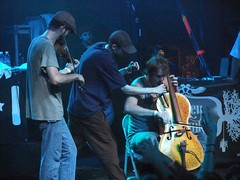
From the first moment, it was clear something was unusual. MC Sloppy Joe started out playing the violin, looping a series of riffs to form the bones of the backing track. Later, MC Funny Biz
beatboxed while he laid down some cello riffs. DJ Steakhouse had a more normal role, bouncing between setting the groove and stepping out front to join in the rapping. Even so, the backing tracks he set were fairly interesting, ranging from lazy jazz lines to Arabic grooves to flute jams.

The three guys are all incredibly well rehearsed and tightly choreographed. They smoothly stole lines from one another and ran through machine gun speed lyrics in unison. The three might have all been controlled by a single mind, but each expressed his own personality at the same time. The lyrical flow was easily the smoothest of any of the acts that night.
The set included several songs from their CD,
Credible Forces, including
Temptations,
Credible Sources, and
Make Believe. They also played at least one song from their upcoming CD,
No Object. Whiskey Blanket has the potential to reach a much wider audience. Keep an ear out for them.
Zion I

If Whiskey Blanket relied on cleverness and an entertaining show,
Zion I's set was more about setting a mood and creating a group connection. The ritual began with DJ
AmpLive coming out and laying electronic textures over a hip hop beat, creating a cross between a club feel and
electro pop.
AmpLive is a different kind of DJ/instrumentalist. Rather than scratching, he does more mixing and heavy electronic processing of base sounds. He manipulates and mutates a basic groove to tickle the ear as well as get the crowd dancing.
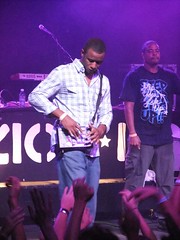
After a couple of songs, the other half of Zion I, MC
Zumbi, came out.
Codany Holiday supported the band by providing the hottest soul singing of the night. The songs often created a mash up between
AmpLive's electronic grooves,
Haliday's crooning, and
Zumbi's solid rap.
Zumbi stayed center stage and provided the focus for the mood they wanted to create. Sure, there was a sense of "party and have a good time", but that was tempered by more socially conscious raps and positive messages.
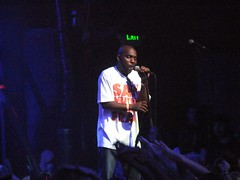
A perfect example of the balance was
Antenna which started with a strong soul vocal testimony, which was overtaken by a club beat
electronica feel.
Zumbi's lyrics
Every breath is a prayer
We still livin'
World's still spinnin'
I'm still thanksgivin'
...
So what should I do?
When can I
Talk to you
Through my antenna?
It's bouncy, fun, and danceable, but there's still a good message in there.
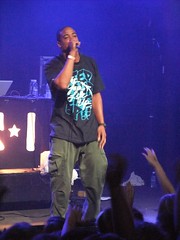
Zion I played a number of their familiar songs, including
Fingerpaint,
The Bay, and
Coastin'. This last didn't drop until the encore, but was worth the wait. Speaking of
encore's, the encore started with Zion I coming back, but they invited all of the out of
staters on stage to join. This gave the
Bayliens and some other guests a chance to hit the stage again. This turned into a freestyle contest. Everyone gave their best shot, but
Zumbi had the edge.
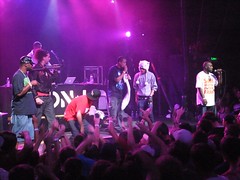
This was a long, late show covering a wide range of what hip hop can be. I need a 6 shot espresso just to keep up.
More photos on my
Flickr.
 Lead singer John Van Deusen's voice wafts across the songs on The Lonely Forest EP like the ghost of Michael Stipe, but there's a core of clarity. Van Deusen wants to be understood and to reach the listener. He sounds earnest and humble on this small debut offering. At first hearing, the music is direct indie rock, but progressive art rock sounds are lurking around the edges, adding complexity.
Lead singer John Van Deusen's voice wafts across the songs on The Lonely Forest EP like the ghost of Michael Stipe, but there's a core of clarity. Van Deusen wants to be understood and to reach the listener. He sounds earnest and humble on this small debut offering. At first hearing, the music is direct indie rock, but progressive art rock sounds are lurking around the edges, adding complexity.





















